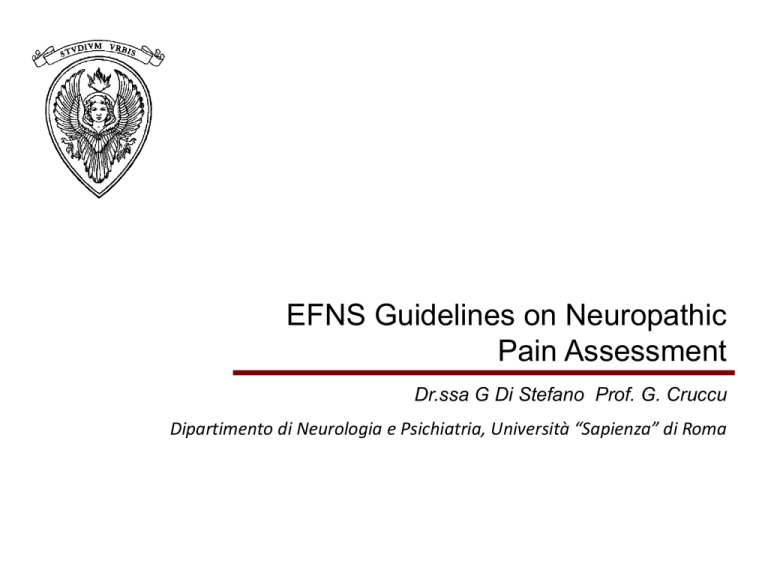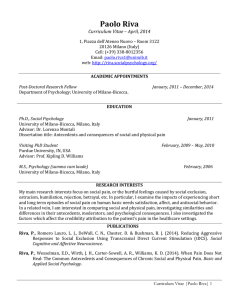Attal et al., Eur J Neurol 2010
advertisement

EFNS Guidelines on Neuropathic Pain Assessment Dr.ssa G Di Stefano Prof. G. Cruccu Dipartimento di Neurologia e Psichiatria, Università “Sapienza” di Roma Dolore neuropatico Neuropathic pain is pain arising as a direct consequence of a lesion or disease affecting the somatosensory system Treede et al., Neurology 2008 Current therapeutic targets Current therapeutic targets Nerve excitability Peripheral sensitization -Topical lidocaine -Capsaicin -Sodium channel blockers Current therapeutic targets Nociceptive transmission Central sensitization -2δ ligands (Gabapentin, Pregabalin) Sensitizzazione centrale Current therapeutic targets Nociceptive transmission Central sensitization -2δ ligands (Gabapentin, Pregabalin) Current therapeutic targets Descending control Segmental inhibition -Antidepressant (SNRI, TCA) -Opioids (Tramadol, Oxycodone) Future therapeutic targets Nerve excitability Peripheral sensitization - Novel Sodium channel blockers (Ralfinamide) - Potassium channel blockers (Retigabine) Gene expression -GDNF, Anti-NGF Nociceptive transmission Central sensitization AMPA antagonists (Terampanel) Microglial activation - Cytokine inhibitors - MAPK inhibitors EFNS guidelines Condition Level A rating for efficacy Level B rating for efficacy Recommendations for first line Recommendations for second line Diabetic NP Duloxetine Gabapentin-morphine TCA Gabapentin Oxycodone Pregabalin TCA Tramadol alone or with Paracetamol Venlafaxine ER BTX-A** Dextromethorphan Gabapentin/ Venlafaxine** Levodopa** Duloxetine Gabapentin Pregabalin TCA Venlafaxine ER Opioids Tramadol PHN Capsaicin 8% patch* Gabapentin Gabapentin ER Lidocaine plasters Opioids Pregabalin TCAa Capsaicin cream Valproate** Gabapentin Pregabalin TCA Lidocaine plasters Capsaicin Opioids Classic TN Carbamazepine Oxcarbazepine Carbamazepine Oxcarbazepine Surgery Central pain Cannabinoids (oro-mucosal* oral) (MS) Pregabalin (SCI) Lamotrigine (CPSP) TCA (SCI, CPSP) Tramadol (SCI)** Opioids Gabapentin Pregabalin TCA Cannabinoids (MS) Lamotrigine Opioids Tramadol (SCI) Attal et al., Eur J Neurol 2010 Recommendations from EFNS guidelines Condition Level A rating for efficacy Level B rating for efficacy Recommendations for first line Recommendations for second line Diabetic NP Duloxetine Gabapentin-morphine TCA Gabapentin Oxycodone Pregabalin TCA Tramadol alone or with Paracetamol Venlafaxine ER BTX-A** Dextromethorphan Gabapentin/ Venlafaxine** Levodopa** Duloxetine Gabapentin Pregabalin TCA Venlafaxine ER Opioids Tramadol PHN Capsaicin 8% patch* Gabapentin Gabapentin ER Lidocaine plasters Opioids Pregabalin TCAa Capsaicin cream Valproate** Gabapentin Pregabalin TCA Lidocaine plasters Capsaicin Opioids Classic TN Carbamazepine Oxcarbazepine Carbamazepine Oxcarbazepine Surgery Central pain Cannabinoids (oro-mucosal* oral) (MS) Pregabalin (SCI) Lamotrigine (CPSP) TCA (SCI, CPSP) Tramadol (SCI)** Opioids Gabapentin Pregabalin TCA Cannabinoids (MS) Lamotrigine Opioids Tramadol (SCI) Attal et al., Eur J Neurol. 2010 Opioid use Italy Breivik et al., Ann Oncol 2009 Safety concerns about opioids • The lack of long-term studies of opioids in chronic noncancer patients pain was one of the main objections raised in published guidelines and reccomendations1 • One study of slow-release oxycodone (average dose 52.5 mg) followed-up 233 patients for 36 months2 − 10% of patients required an increase in their average daily dose from month 122 − 2.6% developed abuse/dependency2 • However, these are only the first results. More controlled, long-term studies, and QoL assessments are needed1 1. Attal et al., Eur J Neurol 2010; 2. Portenoy et al., Clin J Pain 2007 Opioid adverse events Adverse events Trials Number/total (%) Opioid Placebo Constipation 8 275/673 (41) 50/441 (11) Nausea 8 215/673 (32) 52/441 (12) Somnolence/sedation 7 178/627 (29) 37/395 (10) Vomiting 7 91/602 (15) Dizziness 8 132/673 (20) 33/441 (7) Itching 6 83/556 (15) 23/324 (7) Dry mouth 7 76/585 (13) 37/396 (9) Headache 4 35/437 (8) 28/240 (12) 10/370 (3) Relative risk (95% CI) 3.6 (2.7–4.7) 2.7 (2.1–3.6) 3.3 (2.4–4.5) 6.1 (3.3–11) 2.8 (2.0–4.0) 2.2 (1.4–3.3) 1.5 (1.0–2.1) 0.8 (0.5–1.3) NNH (95% CI) 3.4 (2.9–4.0) 5.0 (4.0–6.4) 5.3 (4.3–7.0) 8.1 (6.4–11) 8.2 (6.3–12) 13 (8.4–27) Not calculated Not calculated Kalso et al., Pain 2004 Oxycodone - Naloxone Changes in bowel function index Oxy-N vs Oxy Changes in intensity of pain Oxy-N vs Oxy Clemens et al., Int J Clin Pract. 2011 Recommendations from EFNS guidelines Condition HIV Neuropathy Level A rating for efficacy Capsaicin 8% patch Smoked Cannabis Post traumatic or post surgical NP Level B rating for efficacy Lamotrigine Amitriptyline Botulinum Toxin-A Cancer NP GBP Phantom pain Morphine Tramadol Multiaetiology NP Bupropion Cannabinoids (oromucosal, synthetic analogue) Levorphanol Amitriptyline Tramadol Methadone TCA (nortriptyline, clomipramine) Attal et al., Eur J Neurol. 2010 RCT in central post-stroke pain Drug Study design Number of patients Dose Outcome Reference Amitriptyline Cross-over 15 75 mg Positive (NNT: 1.7) Leijon and Boivie, 1989 Carbamazepine Cross-over 15 800 mg Negative Leijon and Boivie, 1989 Lamotrigine Randomized cross over 30 400 mg Positive Vestergaard et al., 2001 Pregabalin Randomized Parallel 19 300-600 Positive Levorphanol Randomized parallel 10 0.15 mg Positive (23% Rowbotham 0.75 mg mean decrease et al., 2003 in pain) Duloxetine Randomized parallel 6 60-120 mg Negative Vranken et al., 2008 Vranken et al., 2011 RCT in Multiple Sclerosis-related pain Drug Study design Pain condition Number Results Reference Cannabinoids (THC - cannabidiol) Randomized, double-blind Unspecified type of pain 630 Positive Zajicek et al., 2003 Cannabinoids (THC - cannabidiol) Randomized, double-blind, cross-over study Unspecified type of pain 18 Positive Wade et al., 2003 Cannabinoids (THC - cannabidiol) Randomized, double-blind Unspecified type of pain 160 Negative Wade et al., 2004 Cannabinoids (THC - cannabidiol) Randomized, double-blind Spontaneous or evoked chronic neuropathic pain 66 Positive Rog et al., 2005 Cannabinoids (Dronabinol) Randomized, double-blind, cross-over Central neuropathic spontaneous pain 24 Positive Svendsen et al., 2004 Lamotrigine Randomized, double-blind, crossover study Unspecified type of pain 12 Negative Breuer et al., 2007 Levetiracetam Randomized, single-blind 20 Negative/Positive Rossi et al., 2009 Levorphanol Doubleblind,dose– response study Constant or intermittent sensory symptom with unpleasant feelings or pain Unspecified type of pain 8 Negative/Positive Rowbotham et al., 2003 Truini et al., Expert Opin Pharmacother 2011 Guidelines on neuropathic pain treatment EFNS NeuPSIG NICE AAN First line treatment Pregabalin Gabapentin TCA SNRI Pregabalin Gabapentin TCA SNRI TCA Duloxetine Pregabalin Pregabalin Second line treatment Tramadol Oxycodone Tramadol Opioid agonists (Morphine, oxycodone, methadone, levorphanol) Switch to or combination of the first line drugs Gabapentin, Sodium valproate, SNRI TCA Dextromethorphan, Morphine Tramadol Oxycodone Bupropion, SSRI, Carbamazepine, Lamotrigine, Oxcarbazepine, Topiramate, Valproic acid Tramadol Third line treatment Guidelines on neuropathic pain treatment EFNS NeuPSIG NICE AAN First line treatment Pregabalin Gabapentin TCA SNRI Pregabalin Gabapentin TCA SNRI TCA Duloxetine Pregabalin Pregabalin, Second line treatment Tramadol Oxycodone Tramadol Opioid agonists (Morphine, oxycodone, methadone, levorphanol) Switch to or combination of the first line drugs Gabapentin, Sodium valproate, SNRI TCA Dextromethorphan, Morphine Tramadol Oxycodone Bupropion, SSRI, Carbamazepine, Lamotrigine, Oxcarbazepine, Topiramate, Valproic acid Tramadol Third line treatment 1) 13% of patients suffering from PHN did not receive any treatment: low pain intensity or underestimation of PHN in clinical practice?; 2) Nearly 25% of patients was treated with a 1st medication, alone or in combination with other treatments: did clinicians neglect evidence-based recommendations? 3) More than 50% of patients started the treatment with 2nd or 3rd line medications; 4) Nearly 25% of patients was treated with a 3rd line medication, or a not-recommended one: role of the clinical practice against evidence based recommendations. THANK YOU!


